In the eyes of many small business owners, office planning is regarded as a subject to which only companies large enough to warrant employing their own office manager could afford to give more than passing consideration. Managers of new ventures in the first throes of development are much more likely to be caught up in the excitement of generating new leads and keeping existing clients or customers happy, and there is a strong tendency to adopt an attitude of laissez-faire when it comes to even the most basic principles of the organized office environment. However, no business is so small that it can afford to ignore the benefits of efficiently planned accommodation.
Although there is a great deal of satisfaction to be derived from a close personal involvement in a small but growing concern, any business in such a situation will inevitably be generating more and more paperwork, will need to recruit more personnel and be making large investments in furniture like for the office seating and other equipment. They may also need to purchase bulk office supplies to ensure everyone will have sufficient supplies.
One filing cabinet, two telephones and a pocket calculator may have been sufficient to cope with requirements in the early days, but it is a situation which is likely to become increasingly strained as the two-man band develops into a 10 or 20 piece orchestra.

First, considerable thought should be given to a few basic Principles of office planning, particularly in the light of a decision to acquire more space. This is probably one of the most important and significant first steps in the life of a small company one which represents a major investment. Miscalculations or lack of thought can, and commonly do, lead to extremely expensive mistakes which can affect the rate of development for years come. For example, a decision to acquire accommodation based simply on average space per head and cost per square foot calculation can go badly adrift. The square footage quoted by estate agents often includes some degree of unusable space, so what initially looks like a very favourable rent may not be so attractive once this factor is taken into consideration. A brief layout or plan of the actual floor area offered is essential to ensure that there is enough space for staff and equipment.
The tendency is to take just enough space to suit the company’s current requirements, but the importance of developing a plan to cope with future short- and long-term needs when more staff will be taken on cannot be underestimated. This could, for example, involve the acquisition of more space than is needed and organising a sensible sub-let which provides for an option to take over the additional space after a period of time. One way or another, it is essential to allow for growth and expansion to protect the firm against the unsettling and disruptive process of moving more frequently than is necessary.
The next consideration, once premises have been found, must be their layout, fitting out and furnishing. It is again worth assessing the working needs of the staff, in terms of equipment and their inter-relationship with each other, and planning accordingly. To take a simple example, it is distracting for someone involved in the preparation of detailed figure work or reports to share a small office with a heavy telephone user; the efficiency of both is likely to be impaired. The location and siting of furniture and equipment should be given at least as much thought as most people devote to planning a new kitchen. The furniture selected should be carefully chosen to meet the needs of the user in terms of his or her job function and not just because it looks good and doesn’t cost too much.
Few small businesses can afford the luxury, in terms of space or manning power, of a full reception area, but an assessment of the number and nature of callers received is still a worthwhile exercise. See here for a wide selection of reception counters that will make your office stand out. A suitably furnished waiting area to create the right first impression is necessary if visitors consist of clients and customers to whom a certain image is to be conveyed. On the other hand, that image may be tarnished if the waiting visitor is able to overhear irate telephone conversations with recalcitrant suppliers.
The choice of the right commercial storage equipment will also make an important contribution to the smooth running of the business, and help to prevent that ‘drowning in paper’ feeling from which many small operations (and some larger companies) suffer. A simple inhouse survey of the type of material which needs to be stored, from correspondence, order forms and blank invoices t0 ledgers and reference books, will provide a specification for appropriate system. Once the analysis has been made, advice from one or two office equipment sales people should be helpful in providing information on a simple yet flexible system to meet your needs. It is only too easy to fall back on traditional box files which are comparatively expensive, wasteful in terms of space, and rapidly become a general dumping ground for irrelevant material.
There is also a tendency for small businesses to overlook the recent advances in office automation, or to dismiss the more sophisticated equipment because of cost. No office nowadays would be without a calculator, which has become smaller and more powerful than ever before, and is now within the reach of everyone’s pocket. Yet this advancement has, in fact, been mirrored in many other fields of office technology.

Electronic typewriters, the simplest form of word processors, have become much less expensive, and at around £1000 equate with the financial outlay necessary for two ordinary electric typewriters. Even a microcomputer is now within the reach of many small firms. A computer terminal with telephone link to a bureau has, in fact, been installed in our own offices (where we have a staff of 30), for the purposes of cost control, manpower planning and project programming. The use of a computer to carry out these functions would have been beyond the wildest dreams of most companies of our size even five years ago.
There is one further aspect relating to the organised office, of which every business should be aware. The terms of the Health and Safety at Work Act affect all employers, and potential sources of accidents, such as trailing telephone or electrical wires or a blocked fire exit, could attract an enforcement notice, the execution of which could prove expensive.
Taken step by step, the road to a properly planned office is within the reach of any business, whatever its size.